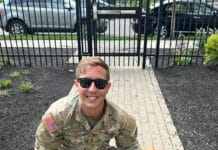14,800.
That’s the number of people who die every year from unintentional overdose of opioids, commonly known as painkillers— it’s higher than the number of overdose deaths from cocaine and heroin use combined and higher than the number of automobile deaths. That shocking fact was shared with me as I toured the Minneapolis VA Medical Center to learn more about pain management, and how our staff in Minneapolis is revolutionizing team-oriented care.
Our nation didn’t arrive at an opioid crisis overnight, so it’s important to understand how we got here. Professional associations in the 1990s besieged medical journals and health care providers with the idea of untreated pain as a medical crisis. Those charts you’ve probably seen at the doctor’s office—faces with pain numbers—went up across the country, and pharmaceutical companies pressed doctors to fill more opioid prescriptions.
From 1999 to 2010, prescriptions for opioids increased by 400 percent, according to the Center for Disease Control. As a result, overdose deaths also rose 400 percent. Patients sought opioids and gravitated to doctors willing to prescribe them despite side effects like sedation and decreased testosterone. Widespread addiction and an alarming rise of overdose deaths prompted the medical community to rethink its approach to opioids, such as OxyContin, as a silver bullet to pain management.
The pain management staff at the Minneapolis VA Medical Center, led by Dr. Peter Marshall, transformed mounting medical research into action. In 2011, the team established the Opioid Safety Initiative to bring down the use of OxyContin and high dose opioids among chronic pain sufferers—usually Veterans with issues like chronic back and neck pain and arthritis. Other formulary medications, along with a greater emphasis on behavioral chronic pain management like yoga and exercise, were deployed to help Vets deal with their ailments.
The results are drastic. As of May 2013, OxyContin use at the Minneapolis VA Medical Center has plummeted 94 percent, and high dose opioid use has fallen 55 percent since the implementation of the Opioid Safety Initiative. More behavioral pain management and generic medications have also been utilized.
The model of care itself has been transformed as well. Dr. Marshall’s staff took cues from team-centered treatments of issues such as diabetes and applied it to pain management in a system called stepped care management. A full spectrum of care brings medical professionals together to holistically target and treat chronic pain affected Veterans. It’s a model that shows promising signs for not only VA’s medical system, but the private health care system at large.
There are so many advances in medicine throughout VA’s 152 medical centers that it’d be impossible to track them all. This is just another example of great minds coming together to help solve pressing issues affecting not only Veterans, but society in general, getting them back to living their lives as easily—and as painless—as possible.

All content herein is owned by author exclusively. Expressed opinions are NOT necessarily the views of VNR, authors, affiliates, advertisers, sponsors, partners, technicians, or VT Network. Some content may be satirical in nature.
All images within are full responsibility of the author and NOT VNR.
Read Full Policy Notice - Comment Policy






























Ok, let’s us see: Other formulary medications, along with a greater emphasis on behavioral chronic pain management like yoga and exercise, were deployed to help Vets deal with their ailments.
Burned over 50% of body, missings limbs, then 2 deal with BIG PAIN we git this: Other formulary medications, along with a greater emphasis on behavioral chronic pain management like yoga and exercise, were deployed to help Vets deal with their ailments.
How will the methods will help Veterans who can’t git into these postitions? Answer that !, Boss!!!!! I’m 1, but I have learn to put the pain aside, old jarhead(no brain, no pain) + German mindset!!!! Just sayin’, guys!!!!
ONLY ONE SIDE OF THE STORY
We are not told who wrote this article of praise for only one side of a complex issue.
In my extensive experience, Chronic Pain sufferers have been too long denied the competent care they deserve by a narcophobic medical society.
My comment, yesterday was censored for questioning this apparently gleeful denial of opiates when all other options have been exhausted.
I would encourage VT to cite statistics of chronic pain sufferers who have turned to suicide because a life of untreated pain is not a life. It is a sentence to daily misery without hope.
This article seems to praise the infliction of that sentencing by those who neither suffer chronic pain nor have the ability to grasp its complexities.
“SELF CONGRATULATORY NARCO-PHOBES A BANE TO REAL PAIN”
We are not told by this gang of gleeful narcophobes how many people commit suicide or die from withdrawals or chronic pain.
We only hear one side of the story told by these cluelessly pain free gang of arrogant neo Prohibitionists.
Mine is a different story perhaps guided by theirs.
At McGuire’s V.A. Pain Clinic, I reported stolen meds. and was cut off completely from a very high dose of prescribed opiates. This was knowingly done in violation of all V.A. Medical Guidelines. I was given no valid reason, had no recourse, faced tampered records and was ignored & dismissed to a hellish 3 months of withdrawals & pain.
My “infraction” was covered by the required Police Report which these criminal Docs ignored while send me on an unsupervised “Medication Vacation”
They continue to prey on other Vets with impunity as far as I know.
A pain free Dr. Lester spearheaded this abuse and remains on the job.
I am embittered and unimpressed by the successes of these pain free narcophobes who delight in their success at inflicting suffering on those of us for which opiates are an only option to injuries incurred in the line of duty.
May they suffer the misery they inflict on legitimate, chronic pain sufferers for which opiates are an only relief.
Gray
Comments are closed.